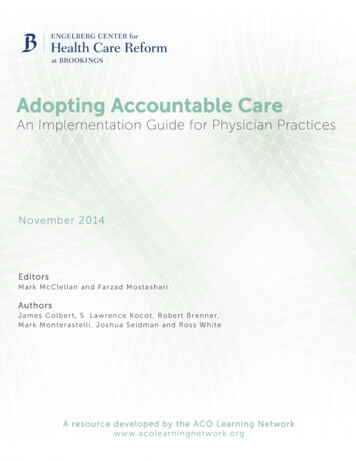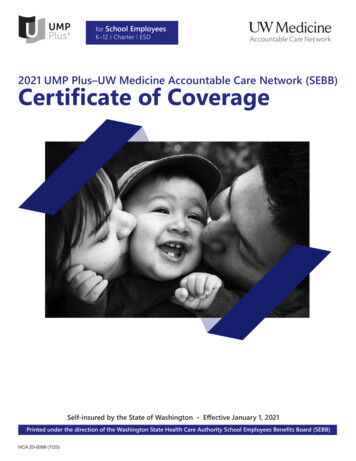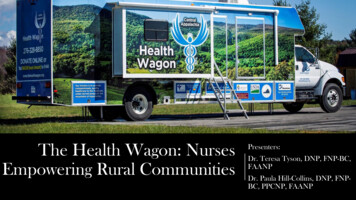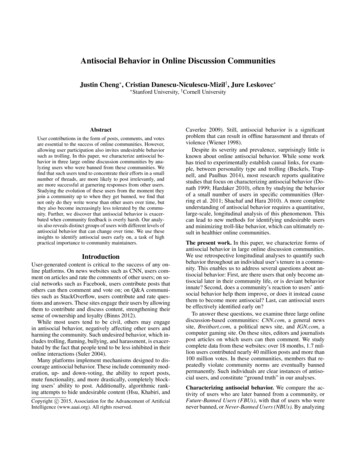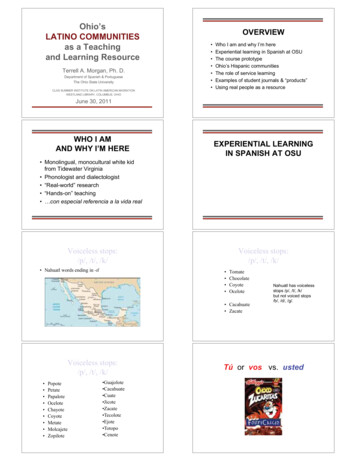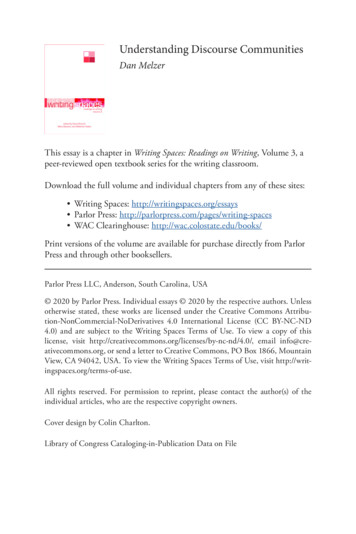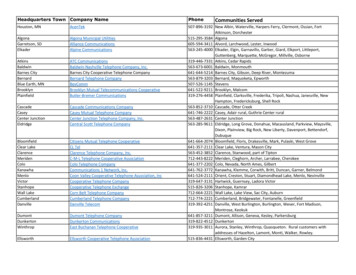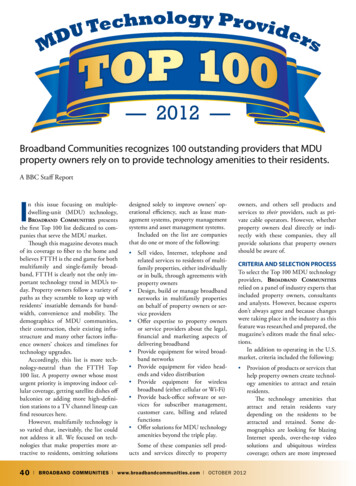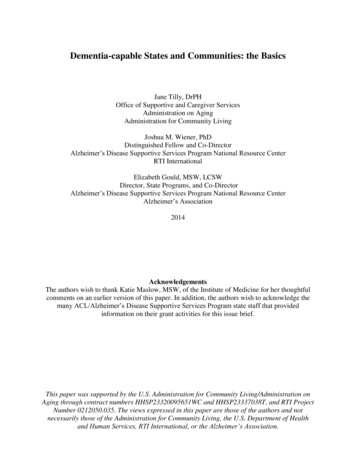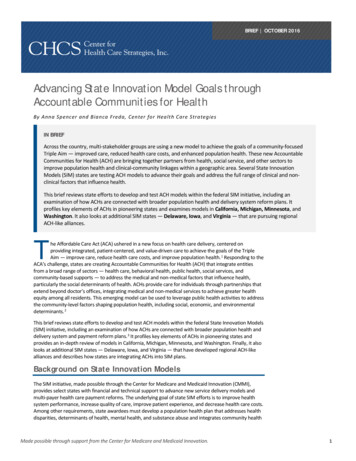
Transcription
BRIEF OCTOBER 2016Advancing State Innovation Model Goals throughAccountable Communities for HealthBy Anna Spencer and Bianca Freda, Center for Health Care StrategiesIN BRIEFAcross the country, multi-stakeholder groups are using a new model to achieve the goals of a community-focusedTriple Aim — improved care, reduced health care costs, and enhanced population health. These new AccountableCommunities for Health (ACH) are bringing together partners from health, social service, and other sectors toimprove population health and clinical-community linkages within a geographic area. Several State InnovationModels (SIM) states are testing ACH models to advance their goals and address the full range of clinical and nonclinical factors that influence health.This brief reviews state efforts to develop and test ACH models within the federal SIM initiative, including anexamination of how ACHs are connected with broader population health and delivery system reform plans. Itprofiles key elements of ACHs in pioneering states and examines models in California, Michigan, Minnesota, andWashington. It also looks at additional SIM states — Delaware, Iowa, and Virginia — that are pursuing regionalACH-like alliances.The Affordable Care Act (ACA) ushered in a new focus on health care delivery, centered onproviding integrated, patient-centered, and value-driven care to achieve the goals of the TripleAim — improve care, reduce health care costs, and improve population health.1 Responding to theACA’s challenge, states are creating Accountable Communities for Health (ACH) that integrate entitiesfrom a broad range of sectors — health care, behavioral health, public health, social services, andcommunity-based supports — to address the medical and non-medical factors that influence health,particularly the social determinants of health. ACHs provide care for individuals through partnerships thatextend beyond doctor’s offices, integrating medical and non-medical services to achieve greater healthequity among all residents. This emerging model can be used to leverage public health activities to addressthe community-level factors shaping population health, including social, economic, and environmentaldeterminants. 2This brief reviews state efforts to develop and test ACH models within the federal State Innovation Models(SIM) initiative, including an examination of how ACHs are connected with broader population health anddelivery system and payment reform plans. 3 It profiles key elements of ACHs in pioneering states andprovides an in-depth review of models in California, Michigan, Minnesota, and Washington. Finally, it alsolooks at additional SIM states — Delaware, Iowa, and Virginia — that have developed regional ACH-likealliances and describes how states are integrating ACHs into SIM plans.Background on State Innovation ModelsThe SIM initiative, made possible through the Center for Medicare and Medicaid Innovation (CMMI),provides select states with financial and technical support to advance new service delivery models andmulti-payer health care payment reforms. The underlying goal of state SIM efforts is to improve healthsystem performance, increase quality of care, improve patient experience, and decrease health care costs.Among other requirements, state awardees must develop a population health plan that addresses healthdisparities, determinants of health, mental health, and substance abuse and integrates community healthMade possible through support from the Center for Medicare and Medicaid Innovation.1
BRIEF Advancing State Innovation Model Goals through Accountable Communities for Healthand prevention into their delivery system and payment models.4 Several states are testing ACH models asa way to advance SIM goals and address the full range of clinical and non-clinical factors that influencehealth. These states are exploring how ACH models will operate within broader delivery system andpayment reform efforts, including patient-centered medical homes (PCMH), behavioral health integrationmodels, accountable care organizations (ACOs), value-based reimbursement, care coordination efforts,community health teams, efforts to target high-need, high-risk populations, and Medicaid waiverdemonstrations.The Role of Accountable Communities for Health in StateInnovation ModelsThe idea of multi-stakeholder groups working together toward attaining a community-focused Triple Aimis not new. In 2012, Magnan and colleagues from the Minnesota Department of Health proposed thedevelopment of voluntary regional organizations called accountable health communities to work withhealth system stakeholders in reviewing local data on health, experience, and quality of care in order todevelop strategies to meet the Triple Aim.5Since then, the ACH concept has become more firmly rooted in communities across the US. ACHs, variablyreferred to as accountable health communities, accountable care communities, or community healthinnovation regions, are generally defined as a coalition of partners from health, social service, and othersectors working together to improve population health and clinical-community linkages within ageographic area. For this paper, the term ACH is used to refer to all models. The ACH model facilitatescross-sector collaboration to address the full range of factors that influence health, including access tomedical care, public health, genetics, behaviors, social factors, economic circumstances, andenvironmental factors.The CDC’s “Three Buckets of Prevention” framework is useful for understanding the role that ACHs play inpopulation health improvement (see Exhibit 1).6 ACHs focus primarily on bucket 2 and 3: innovativeprevention initiatives that extend care outside the clinical setting and total population or community-wideprevention interventions.7 In contrast, traditional delivery transformation and payment reform efforts,such as ACOs or PCMHs, focus primarily on buckets 1 and 2. State seeking to establish a comprehensivepopulation health improvement approach can thus structure ACHs to complement more traditionaldelivery system and payment reforms.Exhibit 1: The 3 Buckets of PreventionSOURCE: J. Auerbach. The Three Buckets of Prevention. Journal of Public Health Management Practice (2016).Advancing innovations in health care delivery for low-income Americans www.chcs.org2
BRIEF Advancing State Innovation Model Goals through Accountable Communities for HealthStates are testing a variety of strategies to integrate ACHs into SIMefforts. For example, some state SIM programs require ACHs topartner with a managed care organization (MCO) or ACO and othersare integrating ACHs into broader delivery system reform efforts. InMinnesota, for example, ACHs must partner with an ACO, and underSIM the state is testing whether health outcomes and costs areimproved when ACOs align with Community Care Teams and ACHsto support integration of health care with non-medical services.10Washington’s ACHs cover geographic regions that togetherencompass the entire state, representing a total population andmulti-payer approach. The ACH regions align directly with thestate’s Medicaid purchasing boundaries, which will help foster thenecessary linkages and supportive environments to address theneeds of the whole person, including a shift toward fully integratedand value-based purchasing, starting with Medicaid. Additionally,through its Section 1115 Medicaid demonstration waiverapplication, Washington State is proposing a Delivery SystemReform Incentive Payment program (DSRIP) that will link deliverysystem transformation activities to measureable outcomes,coordinated and directed by the ACHs across the state. The ACHswill be expected to act as primary point for accountability for thestate and will convene providers to coordinate healthtransformation activities, implement interventions, connect clinicaland community-based organizations, and track regional healthimprovement tied to payment.Centers for Medicare & MedicaidServices: Accountable Health CommunityModelIn support of the Triple Aim goals and growingevidence that linking high-cost beneficiaries to socialservices can improve health outcomes and reducecosts, the Centers for Medicare & Medicaid Services(CMS) recently announced a five-year, 157 millionAccountable Health Communities (AHC) model thatwill test whether addressing health-related socialneeds among dually eligible Medicare and Medicaidbeneficiaries who live in the community can reducehealth care costs and utilization.8 The AHC modelencourages enhanced community-clinical linkages indeveloping and implementing approaches to solvingunmet social needs, such as food insecurity andhousing instability. Through the AHC program,communities throughout the country will launch avariety of transformation efforts testing differentpayment methods. The ultimate goal of CMS’ fiveyear test is to “accelerate the development of ascalable delivery model for addressing upstreamdeterminants of health for Medicare and Medicaidbeneficiaries.”9Core ACH Design ElementsWhile each state has approached the development of ACHs within SIM efforts slightly differently,researchers generally agree on the basic design elements of an ACH. 11,12,13 Below are seven core elementsthat CHCS has identified across models, recognizing that the incorporation of all elements takes time:1.2.3.4.5.6.7.Geography;Mission and vision;Governance;Multi-sector partnerships;Priority focus areas;Data and measurement; andFinancing and sustainability.Following is a discussion of key considerations within each of these core elements and examples from SIMstates (see Exhibit 2 for select ACH features in a sample of SIM states):1. GeographyACHs aim to increase clinical-community linkages and improve population health typically within a specificgeographic area. The geographic boundaries of communities often dictate the numbers of ACHs in a state,sometimes resulting in variable coverage. For example, the nine ACHs in Washington State cover allcounties within the state. By contrast, the initiatives in California, Minnesota, Michigan, and Iowa coveronly certain regions, and in some cases, the ACHs have overlapping geographic boundaries. Beyonddefining an ACH by the community, county, or region served, ACHs may also serve a specific population,including high-risk beneficiaries or those with specific chronic conditions. The Total Care Collaborative ACHAdvancing innovations in health care delivery for low-income Americans www.chcs.org3
BRIEF Advancing State Innovation Model Goals through Accountable Communities for Healthin Minnesota, for example, focuses on increasing person-centered care for people with serious mentalillness living with chemical dependency issues and co-occurring chronic diseases. 142. Mission and VisionAn effective mission statement provides an organizing frameworkfor the ACH. It may define the ACH’s geographic region, the ACH’srole in addressing the full range of determinants that shape health,and in some cases, may make health equity an explicit aim.16 Havinga shared vision among stakeholders can help ensure a clearunderstanding of the purpose and expectations of the ACH, as wellas collective accountability for achieving its goals.3. GovernanceKing County Accountable Community ofHealthBelow is the vision statement from the King CountyAccountable Community of Health in WashingtonState:“By 2020, the people of King County will experiencesignificant gains in health and well-being because ourcommunity worked collectively to make the shiftfrom a costly, crisis-oriented response to health andsocial problems, to one that focuses on prevention,embraces recovery, and eliminates disparities.”15ACHs have diverse governance structures that are driven by staterequirements and guidance as well as the needs of the communitiesin which they operate. The leadership organization — sometimesreferred to as the backbone, integrator, or quarterback organization— plays an essential coordinating role. States have selected anumber of different types of lead agencies, such as public health departments, health systems, communitybased organizations, county health boards, and social service agencies. Key functions can include, but arenot limited to: (1) guiding development of a common vision, goals, and strategy; (2) ensuring communityengagement; (3) facilitating agreements across partner organizations; (4) serving as a coordinator andconvener; (5) managing the ACH budget and mobilizing funding; (6) overseeing data collection, analysis,and evaluation; and (7) ensuring transparency of goals, activities, and outcomes.4. Multi-Sector PartnershipsA range of multi-sector partners is necessary to help an ACH fulfill its mission. While health care providersare important ACH participants uniquely positioned to reach the target population within the community,public health and community and social services organizations, are also critical partners. All ACHs arerequired to be multi-sectoral, although some states are more prescriptive about certain required ACHpartners, such as ACOs, public health, schools, criminal justice, food banks, housing and transportationagencies, and businesses. ACHs need to strike a balance between broad involvement in governance, toensure that regional interests are being appropriately represented, and effective decision making, so thatcoalitions are functional.5. Priority Focus AreasACHs typically have the flexibility to select the health conditions and populations on which to focus. Thisenables ACHs to prioritize the needs of certain sub-populations while simultaneously aligning their effortswith overall population health goals.California, for example, has outlined five core domains — clinical, community, clinical-community linkages,policy and systems change, and environment — to help ACHs focus on a common set of goals, but givesthem the flexibility to design a broad range of interventions.17 In contrast, Michigan’s Community HealthInnovation Regions (CHIRs) must focus on high emergency department (ED) utilizers in the first year ofoperation, but can expand to additional target populations in subsequent years, specifically individualswith multiple chronic conditions or healthy mothers and babies. Similarly, the Iowa ACH-type coalitions,called Community Care Coalitions (C3s), must pursue care coordination interventions that address thestate’s SIM population health focus areas — tobacco, obesity, and/or diabetes — as well as the socialdeterminants of health. Several states are also offering technical assistance to ACH entities: Minnesotaand Michigan are using outside vendors to help develop ACH organizational capacity and facilitate learningcommunities or collaboratives.Advancing innovations in health care delivery for low-income Americans www.chcs.org4
BRIEF Advancing State Innovation Model Goals through Accountable Communities for Health6. Data and MeasurementData sharing, particularly at the local-level, is an essential component to identify community-wide needs,inform ACH activities, and monitor the impact of population-based health efforts. Collecting, aggregating,and sharing health, social services, and financial data from disparate clinical and non-clinical services andprograms, as well as community and population-level data, across a variety of providers and organizationsis thus an important goal for ACHs. Complexities surrounding data selection and/or collection, data privacyand sharing, and infrastructure can pose barriers to implementation. Because many data efforts, such ashealth information exchanges and all-payer claims databases, are still too early in their development toserve as a foundation of an ACH’s measurement approach, few communities have a comprehensive datainfrastructure and platform for sharing at this time.18Through SIM, initial regional-level data efforts are underway to bridge these gaps and integrate data frominsurers, clinical and behavioral health providers, and social service providers (e.g., housing). Minnesotahas formed a data analytics sub-group that includes ACH representatives, which has identified six priorityareas and data sources focused on social and environmental determinants of health.19 The six priorityareas include: mental health and substance use; race, ethnicity and language; access to reliabletransportation; social services; housing status; and, food security. In Washington, the ACHs are receivingdata via regional dashboards through the state’s Analytics, Interoperability and Measurement (AIM)strategy. Through AIM, Washington is investing in infrastructure development and analytic capacity toimprove whole person care and inform health improvement strategies supported by SIM.20Finally, ACHs are wrestling with measuring regional impact, such as quantifying short- and intermediateterm outcomes. Given the short time frame of initiatives in some states, along with the other reformefforts occurring simultaneously, it may be difficult to directly attribute long-term health improvements tothe ACHs. As states think through their ACH models, it is valuable to consider how to measure the impactof these regional collaborative entities from the outset.7. Financing and SustainabilityInitial funding for ACH development has largely been supported by SIM grants in all states. The amount offunding for the ACHs varies by state, with Minnesota committing 5.6 million in SIM funds to 15 ACHprojects over two years, and Washington dedicating 810,000 toward each of its nine ACHs. In California,SIM design funds were used to develop the ACH model, an evaluation framework, and to exploreenhancing community data-sharing capacity. In the absence of SIM test funding, private foundations aresupporting implementation in six communities for up to three years. In Washington, private and publicsector organizations are providing in-kind contributions and grants to specific ACHs to supplement SIMfunds. All ACHs are expected to develop plans for financial sustainability to support the backboneorganization and ongoing health improvement activities.While most states are receiving initial SIM support to develop ACHs, ACHs have reported insufficientresources to meet the social and logistical needs of patients as well as concerns that existing funding willnot sustain ACHs as their role becomes more central to overall state delivery system reform. All statesrequire ACHs to develop a strategy to be self-sustaining post-SIM award period. ACHs and states areconsidering a variety of longer-term financing plans, including health plans; federal, state, and local grants;Medicaid waiver demonstrations; social impact bonds; and hospital community benefit programs, amongothers.21 Some states are considering opportunities to link ACHs to emerging value-based payment (VBP)efforts that instead of rewarding for volume, pay for patient outcomes, which is consistent with ACHgoals.22 ACHs will need to collect outcomes and cost data in order to measure the return on investmentand build the business case for future investment.Advancing innovations in health care delivery for low-income Americans www.chcs.org5
BRIEF Advancing State Innovation Model Goals through Accountable Communities for HealthExhibit 2:Select Key Features of Accountable Communities for onNumberof ACHs6 ACHs6 C3s5 CHIRs15 ACHs9 ACHsGovernance/Backbone ncing Public health agenciesCounty health departmentsMedical centers501c3 non-profitAsthma, violence, obesity, andcardiovascular disease. 850,000 per site over threeyears County health departmentsMedical centerPublic health agenciesCounty boards of health Tobacco use, obesity, and/ordiabetes. May also address SIMstrategies of medicationsafety, patient and familyengagement, communityresource coordination, socialdeterminants of health,hospital acquired infections,and obstetrics. 1,30
partners, such as ACOs, public health, schools, criminal justice, food banks, housing and transportation agencies, and businesses. ACHs need to strike a balance between broad involvement in governance, to ensure that regional interests are being appropriately represented, and ef fecti
